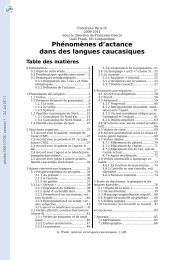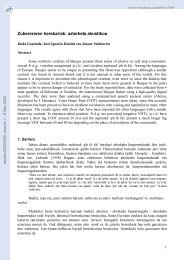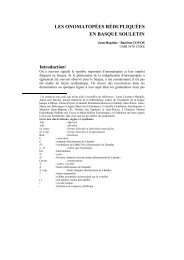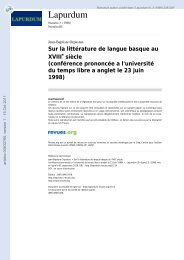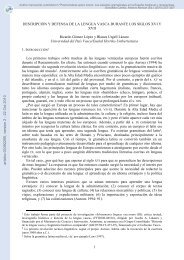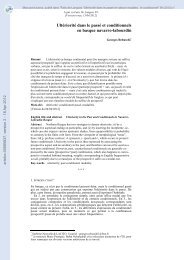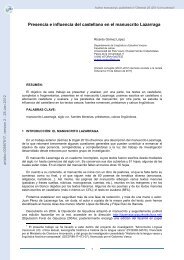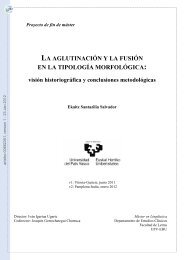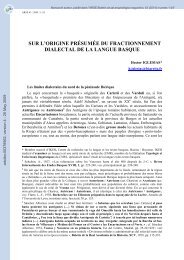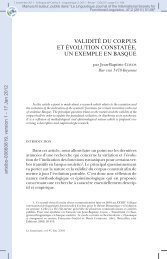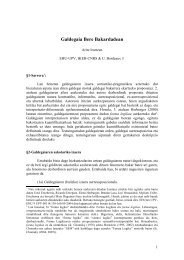On the polysemy of the suffike-ke in the history of Northern Basque
On the polysemy of the suffike-ke in the history of Northern Basque
On the polysemy of the suffike-ke in the history of Northern Basque
Create successful ePaper yourself
Turn your PDF publications into a flip-book with our unique Google optimized e-Paper software.
artxibo-00494270, version 1 - 22 Jun 2010<br />
470 GEORGES REBUSCHI<br />
clear: given that <strong>the</strong> syn<strong>the</strong>tic forms are morphologically simpler, <strong>the</strong>y are unmar<strong>ke</strong>d<br />
- whence also <strong>the</strong>ir use <strong>in</strong> stage directions for example (Rebuschi [1982] 1997).<br />
As for <strong>the</strong> weak verbs, although <strong>the</strong>re does exist a specific imperfective or cont<strong>in</strong>uous<br />
periphrasis, 24 Oyharçabal (ibid.) also notes that (depend<strong>in</strong>g on <strong>the</strong> context<br />
or <strong>the</strong> situation), <strong>the</strong>ir participles <strong>in</strong> -t(z)en can be used with an imperfective, ra<strong>the</strong>r<br />
than iterative, <strong>in</strong>terpretation.<br />
More important is <strong>the</strong> fact that <strong>in</strong> some contexts (typically <strong>in</strong> embedded clauses),<br />
<strong>the</strong> syn<strong>the</strong>tic conjugation is also ambiguous from <strong>the</strong> po<strong>in</strong>t <strong>of</strong> view <strong>of</strong> <strong>the</strong> opposition<br />
between <strong>the</strong> imperfective value and <strong>the</strong> aoristic one; thus datorr.en, <strong>in</strong> which <strong>the</strong> -en<br />
suffix is a complementizer, has two analytic counterparts: 25<br />
(8) a Ez dakit [nor etortzen d.en].<br />
neg I-know who come-imp aux-en<br />
‘I wonder who comes.’ [embedded question]<br />
(b) Nahi dut [etor dadi.(e)n].<br />
want aux √come aux2-en ‘I want him to come’, lit. ‘… that he come’ [governed subjunctive]<br />
An example that illustrates <strong>the</strong> long-stand<strong>in</strong>g alternation between <strong>the</strong> syn<strong>the</strong>tic<br />
and <strong>the</strong> analytic conjugations <strong>in</strong> <strong>the</strong> subjunctive mood is provided <strong>in</strong> (9):<br />
(9) Mk 14,12<br />
LV - Quo vis eamus et paremus tibi ut manduces pascha?/ KJV - Where wilt<br />
thou that we go and prepare that thou mayest eat <strong>the</strong> passover?<br />
a Hnd (1740: Lap.) - Norat nahi duzu goazen eta prepara diezazugun…<br />
b Dv (1859-65: lap.) - Norat nahi duzu goan gaitezen behar denaren zuri<br />
apha<strong>in</strong>tzera…<br />
c Léon (1946: B-N) - Norat nahi duzu goazen… 26<br />
24 With <strong>the</strong> adjective ari «busy» (Trask 1995). What shows that <strong>the</strong> lexical verb which precedes<br />
ari, and ends <strong>in</strong> -t()zen is not an imperfective participle, but a nom<strong>in</strong>alised form, is <strong>the</strong> fact that <strong>the</strong> direct<br />
objet ei<strong>the</strong>r must (<strong>in</strong> Soulet<strong>in</strong>) or may (<strong>in</strong> <strong>the</strong> o<strong>the</strong>r nor<strong>the</strong>rn dialects) be <strong>in</strong> <strong>the</strong> genitive case, ra<strong>the</strong>r<br />
than <strong>the</strong> zero/absolutive (see also Mounole 2008).<br />
A lesser noted explicitly progressive or cont<strong>in</strong>uous periphrasis consists <strong>in</strong> us<strong>in</strong>g izan ‘be’ (ra<strong>the</strong>r than<br />
egon ‘be/stay’) as a ma<strong>in</strong> verb, also govern<strong>in</strong>g a nom<strong>in</strong>alized form <strong>in</strong> <strong>in</strong> -t()zen. Here are two examples:<br />
(i) Egun batez nangoela zuha<strong>in</strong>tze baten itzalbian neure oren.en α erraiten n<strong>in</strong>tzala β …<br />
‘<strong>On</strong>e day as I was [=sat/lay] <strong>in</strong> <strong>the</strong> shade <strong>of</strong> a tree, ([and] as I was) say<strong>in</strong>g β my prayers α [gen]…’<br />
(Tartas 1666: Irakurtzailiari)<br />
(ii) Nuiz nizate<strong>ke</strong> zu.re ikhusten? (Maister 1757: 3,48,3)<br />
when I-shall-be you-gen see<strong>in</strong>g<br />
Quando stabo ad videndum te? / ‘When shall I stand behold<strong>in</strong>g you?’<br />
25 This was already true <strong>in</strong> <strong>the</strong> 16th century: see Lafon (1944: vol. 1, 162-163). The same ambiguity<br />
arises with ano<strong>the</strong>r C° suffix, -(e)la, governed by verbs <strong>of</strong> say<strong>in</strong>g. For <strong>in</strong>stance, datorrr.ela corresponds<br />
ei<strong>the</strong>r to (Erraiten dute) etor dadi.la ‘They say [=order] that he (must) come’ (subjunctive) or to (Erraiten<br />
dute) etor.tzen d.ela ‘They say [=report] that he comes’.<br />
26 In (9a,c), <strong>the</strong> <strong>in</strong>itial g- <strong>of</strong> goazen <strong>in</strong>dicates a 1st p. plural absolutive argument. <strong>On</strong> <strong>the</strong> o<strong>the</strong>r<br />
hand, <strong>in</strong> (9b), <strong>the</strong> <strong>in</strong>itial g- <strong>of</strong> goan is <strong>the</strong> radical prefix <strong>of</strong> <strong>the</strong> typical Lap. form <strong>of</strong> ‘(to) go’ - <strong>in</strong> o<strong>the</strong>r dialects,<br />
<strong>the</strong> prefix is j-. Consequently, <strong>the</strong> <strong>in</strong>itial g- <strong>of</strong> <strong>the</strong> aux 2 gaitezen <strong>in</strong> (9b) is simply (a part <strong>of</strong>) <strong>the</strong> absolutive<br />
prefix g(a)-.<br />
0 ASJU Oyharcabal.<strong>in</strong>dd 470 21/07/09 12:54



